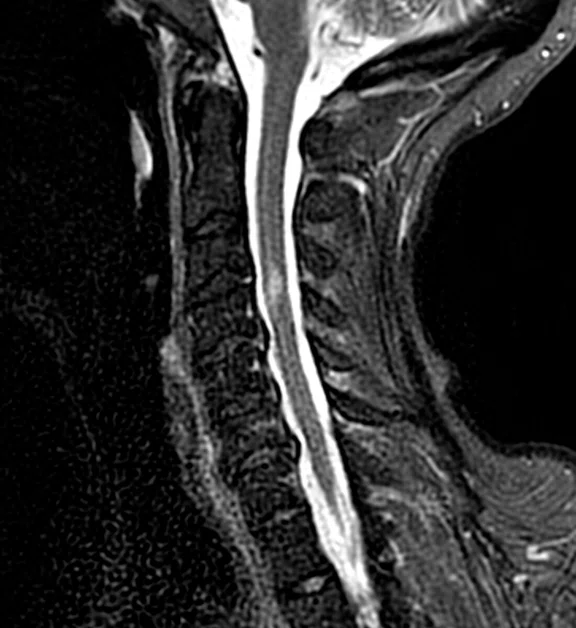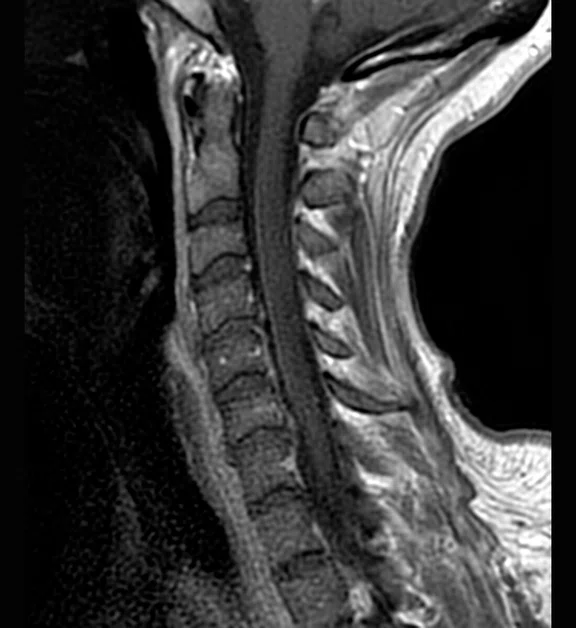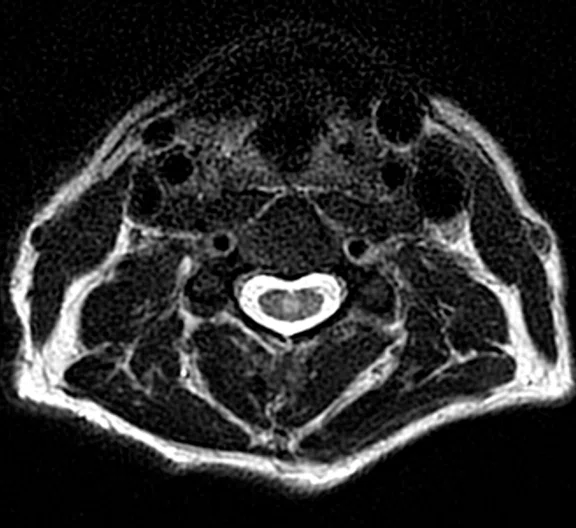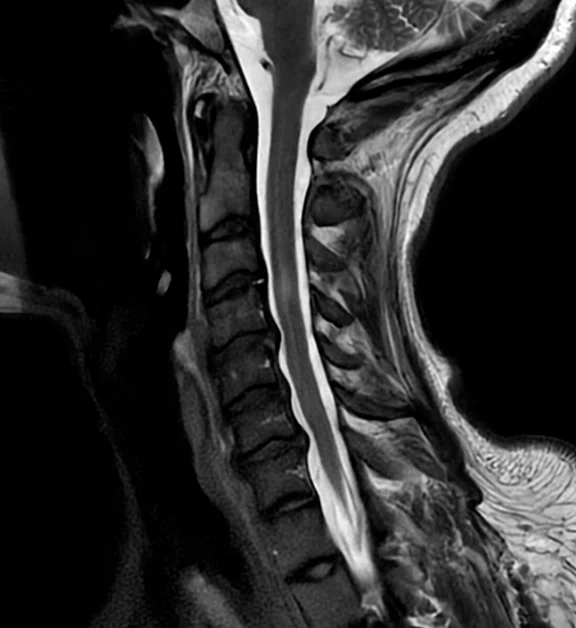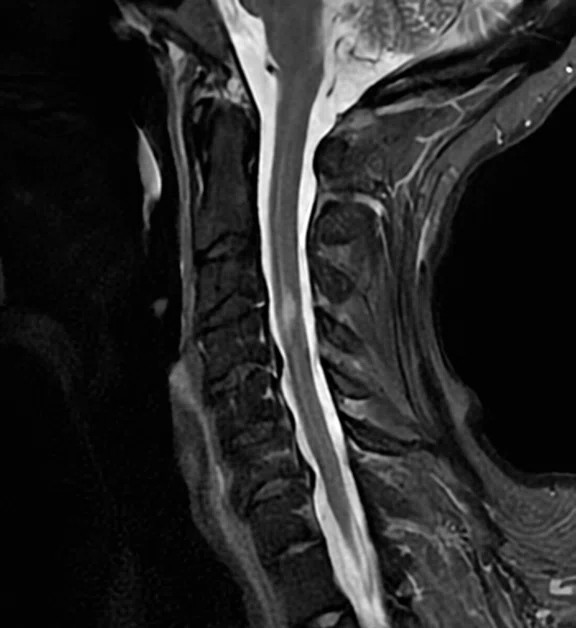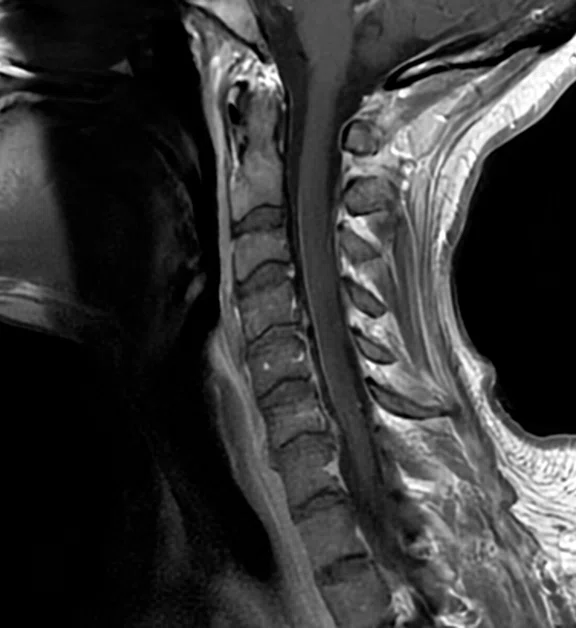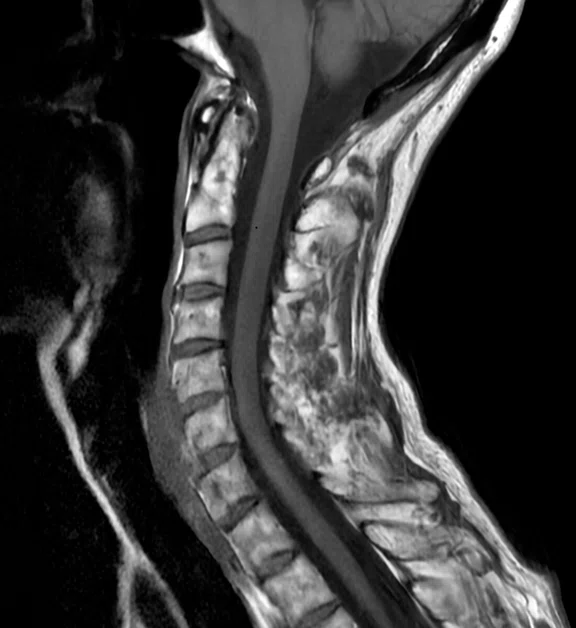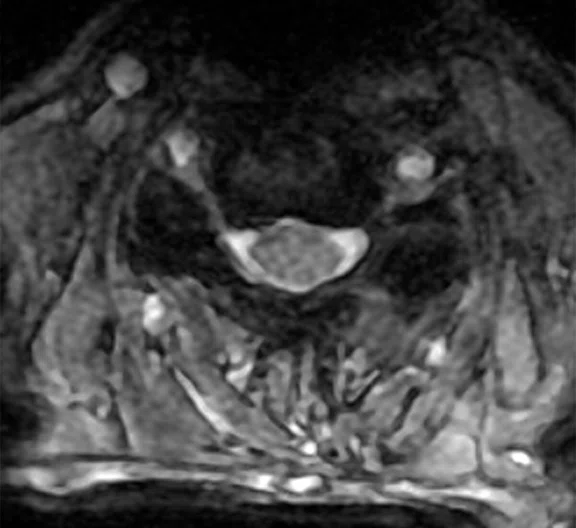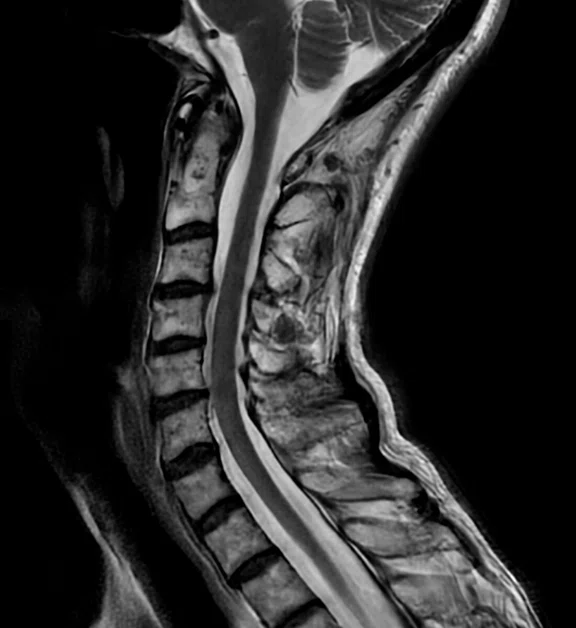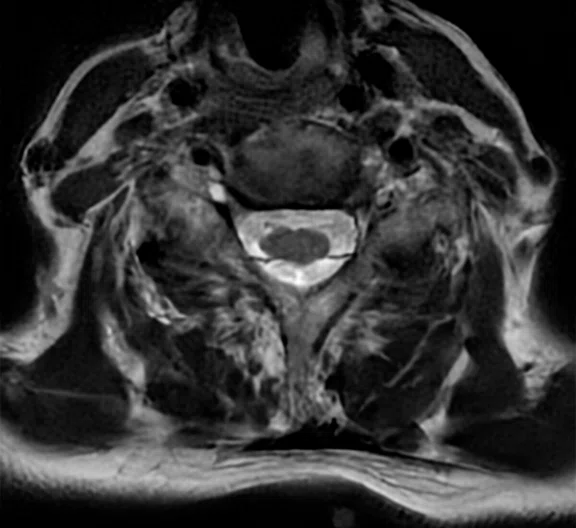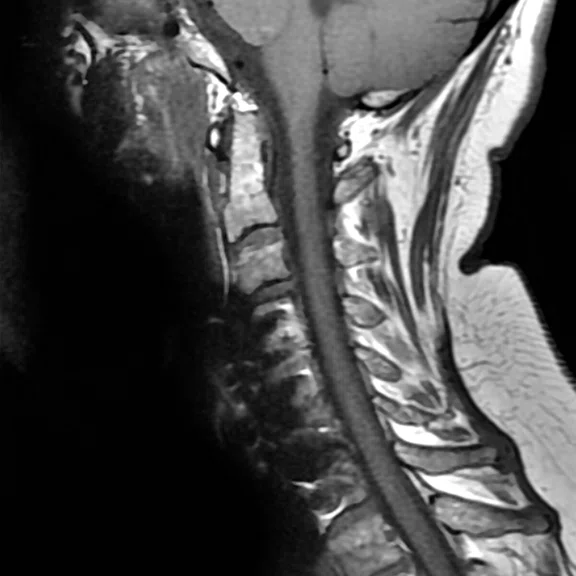A
Figure 3.
Patient with scoliosis and MR-Compatible implanted Harrington rods is unable to lie still due to pain. The 48ch Head Coil was used. (A) Conventional sagittal T2 FSE, 0.5 x 0.8 x 3.0 mm, 1:50 min and (B) sagittal T2 with AIR™ Recon DL PROPELLER, 0.6 x 0.6 x 3.0 mm, 1:42 min.
B
Figure 3.
Patient with scoliosis and MR-Compatible implanted Harrington rods is unable to lie still due to pain. The 48ch Head Coil was used. (A) Conventional sagittal T2 FSE, 0.5 x 0.8 x 3.0 mm, 1:50 min and (B) sagittal T2 with AIR™ Recon DL PROPELLER, 0.6 x 0.6 x 3.0 mm, 1:42 min.
A
Figure 1.
Patient with multiple sclerosis underwent an MR exam for detection of disease-related spine lesions. The 48ch Head Coil was used. Conventional reconstruction of (A) sagittal T2 PROPELLER, (B) sagittal STIR PROPELLER, (C) sagittal T1 PROPELLER with contrast and (D) axial T2 PROPELLER. AIR™ Recon DL PROPELLER reconstructed (E) sagittal T2 PROPELLER, (F) sagittal STIR PROPELLER, (G) sagittal T1 PROPELLER with contrast and (H) axial T2 PROPELLER.
B
Figure 1.
Patient with multiple sclerosis underwent an MR exam for detection of disease-related spine lesions. The 48ch Head Coil was used. Conventional reconstruction of (A) sagittal T2 PROPELLER, (B) sagittal STIR PROPELLER, (C) sagittal T1 PROPELLER with contrast and (D) axial T2 PROPELLER. AIR™ Recon DL PROPELLER reconstructed (E) sagittal T2 PROPELLER, (F) sagittal STIR PROPELLER, (G) sagittal T1 PROPELLER with contrast and (H) axial T2 PROPELLER.
C
Figure 1.
Patient with multiple sclerosis underwent an MR exam for detection of disease-related spine lesions. The 48ch Head Coil was used. Conventional reconstruction of (A) sagittal T2 PROPELLER, (B) sagittal STIR PROPELLER, (C) sagittal T1 PROPELLER with contrast and (D) axial T2 PROPELLER. AIR™ Recon DL PROPELLER reconstructed (E) sagittal T2 PROPELLER, (F) sagittal STIR PROPELLER, (G) sagittal T1 PROPELLER with contrast and (H) axial T2 PROPELLER.
D
Figure 1.
Patient with multiple sclerosis underwent an MR exam for detection of disease-related spine lesions. The 48ch Head Coil was used. Conventional reconstruction of (A) sagittal T2 PROPELLER, (B) sagittal STIR PROPELLER, (C) sagittal T1 PROPELLER with contrast and (D) axial T2 PROPELLER. AIR™ Recon DL PROPELLER reconstructed (E) sagittal T2 PROPELLER, (F) sagittal STIR PROPELLER, (G) sagittal T1 PROPELLER with contrast and (H) axial T2 PROPELLER.
E
Figure 1.
Patient with multiple sclerosis underwent an MR exam for detection of disease-related spine lesions. The 48ch Head Coil was used. Conventional reconstruction of (A) sagittal T2 PROPELLER, (B) sagittal STIR PROPELLER, (C) sagittal T1 PROPELLER with contrast and (D) axial T2 PROPELLER. AIR™ Recon DL PROPELLER reconstructed (E) sagittal T2 PROPELLER, (F) sagittal STIR PROPELLER, (G) sagittal T1 PROPELLER with contrast and (H) axial T2 PROPELLER.
F
Figure 1.
Patient with multiple sclerosis underwent an MR exam for detection of disease-related spine lesions. The 48ch Head Coil was used. Conventional reconstruction of (A) sagittal T2 PROPELLER, (B) sagittal STIR PROPELLER, (C) sagittal T1 PROPELLER with contrast and (D) axial T2 PROPELLER. AIR™ Recon DL PROPELLER reconstructed (E) sagittal T2 PROPELLER, (F) sagittal STIR PROPELLER, (G) sagittal T1 PROPELLER with contrast and (H) axial T2 PROPELLER.
G
Figure 1.
Patient with multiple sclerosis underwent an MR exam for detection of disease-related spine lesions. The 48ch Head Coil was used. Conventional reconstruction of (A) sagittal T2 PROPELLER, (B) sagittal STIR PROPELLER, (C) sagittal T1 PROPELLER with contrast and (D) axial T2 PROPELLER. AIR™ Recon DL PROPELLER reconstructed (E) sagittal T2 PROPELLER, (F) sagittal STIR PROPELLER, (G) sagittal T1 PROPELLER with contrast and (H) axial T2 PROPELLER.
H
Figure 1.
Patient with multiple sclerosis underwent an MR exam for detection of disease-related spine lesions. The 48ch Head Coil was used. Conventional reconstruction of (A) sagittal T2 PROPELLER, (B) sagittal STIR PROPELLER, (C) sagittal T1 PROPELLER with contrast and (D) axial T2 PROPELLER. AIR™ Recon DL PROPELLER reconstructed (E) sagittal T2 PROPELLER, (F) sagittal STIR PROPELLER, (G) sagittal T1 PROPELLER with contrast and (H) axial T2 PROPELLER.
A
Figure 2.
A 75-year-old patient with hyperreflexia (overactive bodily reflexes, twitching), causing significant patient motion, and worsening spondylosis at C5/C6, causing pain. (A) Sagittal T2 FSE with AIR™ Recon DL, 0.5 x 0.8 x 3.0 mm, 1:50 min.; (B) sagittal T1 FSE, 0.5 x 0.8 x 3.0 mm, 1:19 min.; (C) sagittal STIR FSE, 0.6 x 0.8 x 3.0 mm, 1:42 min.; and (D) axial T2* MERGE, 0.7 x 0.9 x 3.0 mm, 2:20 min. Due to patient’s inability to remain still, AIR™ Recon DL PROPELLER was needed. (E) Sagittal T2 with AIR™ Recon DL PROPELLER, 0.6 x 0.6 x 3.0 mm, 1:22 min.; (F) sagittal STIR with AIR™ Recon DL PROPELLER, 0.8 x 0.8 x 3.0 mm, 2:42 min.; (G) sagittal T1 with AIR™ Recon DL PROPELLER, 0.8 x 0.8 x 3.0 mm, 2:21 min.; and (H) axial T2 with AIR™ Recon DL PROPELLER, 0.6 x 0.6 x 3.0 mm, 3:24 min.
B
Figure 2.
A 75-year-old patient with hyperreflexia (overactive bodily reflexes, twitching), causing significant patient motion, and worsening spondylosis at C5/C6, causing pain. (A) Sagittal T2 FSE with AIR™ Recon DL, 0.5 x 0.8 x 3.0 mm, 1:50 min.; (B) sagittal T1 FSE, 0.5 x 0.8 x 3.0 mm, 1:19 min.; (C) sagittal STIR FSE, 0.6 x 0.8 x 3.0 mm, 1:42 min.; and (D) axial T2* MERGE, 0.7 x 0.9 x 3.0 mm, 2:20 min. Due to patient’s inability to remain still, AIR™ Recon DL PROPELLER was needed. (E) Sagittal T2 with AIR™ Recon DL PROPELLER, 0.6 x 0.6 x 3.0 mm, 1:22 min.; (F) sagittal STIR with AIR™ Recon DL PROPELLER, 0.8 x 0.8 x 3.0 mm, 2:42 min.; (G) sagittal T1 with AIR™ Recon DL PROPELLER, 0.8 x 0.8 x 3.0 mm, 2:21 min.; and (H) axial T2 with AIR™ Recon DL PROPELLER, 0.6 x 0.6 x 3.0 mm, 3:24 min.
C
Figure 2.
A 75-year-old patient with hyperreflexia (overactive bodily reflexes, twitching), causing significant patient motion, and worsening spondylosis at C5/C6, causing pain. (A) Sagittal T2 FSE with AIR™ Recon DL, 0.5 x 0.8 x 3.0 mm, 1:50 min.; (B) sagittal T1 FSE, 0.5 x 0.8 x 3.0 mm, 1:19 min.; (C) sagittal STIR FSE, 0.6 x 0.8 x 3.0 mm, 1:42 min.; and (D) axial T2* MERGE, 0.7 x 0.9 x 3.0 mm, 2:20 min. Due to patient’s inability to remain still, AIR™ Recon DL PROPELLER was needed. (E) Sagittal T2 with AIR™ Recon DL PROPELLER, 0.6 x 0.6 x 3.0 mm, 1:22 min.; (F) sagittal STIR with AIR™ Recon DL PROPELLER, 0.8 x 0.8 x 3.0 mm, 2:42 min.; (G) sagittal T1 with AIR™ Recon DL PROPELLER, 0.8 x 0.8 x 3.0 mm, 2:21 min.; and (H) axial T2 with AIR™ Recon DL PROPELLER, 0.6 x 0.6 x 3.0 mm, 3:24 min.
D
Figure 2.
A 75-year-old patient with hyperreflexia (overactive bodily reflexes, twitching), causing significant patient motion, and worsening spondylosis at C5/C6, causing pain. (A) Sagittal T2 FSE with AIR™ Recon DL, 0.5 x 0.8 x 3.0 mm, 1:50 min.; (B) sagittal T1 FSE, 0.5 x 0.8 x 3.0 mm, 1:19 min.; (C) sagittal STIR FSE, 0.6 x 0.8 x 3.0 mm, 1:42 min.; and (D) axial T2* MERGE, 0.7 x 0.9 x 3.0 mm, 2:20 min. Due to patient’s inability to remain still, AIR™ Recon DL PROPELLER was needed. (E) Sagittal T2 with AIR™ Recon DL PROPELLER, 0.6 x 0.6 x 3.0 mm, 1:22 min.; (F) sagittal STIR with AIR™ Recon DL PROPELLER, 0.8 x 0.8 x 3.0 mm, 2:42 min.; (G) sagittal T1 with AIR™ Recon DL PROPELLER, 0.8 x 0.8 x 3.0 mm, 2:21 min.; and (H) axial T2 with AIR™ Recon DL PROPELLER, 0.6 x 0.6 x 3.0 mm, 3:24 min.
E
Figure 2.
A 75-year-old patient with hyperreflexia (overactive bodily reflexes, twitching), causing significant patient motion, and worsening spondylosis at C5/C6, causing pain. (A) Sagittal T2 FSE with AIR™ Recon DL, 0.5 x 0.8 x 3.0 mm, 1:50 min.; (B) sagittal T1 FSE, 0.5 x 0.8 x 3.0 mm, 1:19 min.; (C) sagittal STIR FSE, 0.6 x 0.8 x 3.0 mm, 1:42 min.; and (D) axial T2* MERGE, 0.7 x 0.9 x 3.0 mm, 2:20 min. Due to patient’s inability to remain still, AIR™ Recon DL PROPELLER was needed. (E) Sagittal T2 with AIR™ Recon DL PROPELLER, 0.6 x 0.6 x 3.0 mm, 1:22 min.; (F) sagittal STIR with AIR™ Recon DL PROPELLER, 0.8 x 0.8 x 3.0 mm, 2:42 min.; (G) sagittal T1 with AIR™ Recon DL PROPELLER, 0.8 x 0.8 x 3.0 mm, 2:21 min.; and (H) axial T2 with AIR™ Recon DL PROPELLER, 0.6 x 0.6 x 3.0 mm, 3:24 min.
F
Figure 2.
A 75-year-old patient with hyperreflexia (overactive bodily reflexes, twitching), causing significant patient motion, and worsening spondylosis at C5/C6, causing pain. (A) Sagittal T2 FSE with AIR™ Recon DL, 0.5 x 0.8 x 3.0 mm, 1:50 min.; (B) sagittal T1 FSE, 0.5 x 0.8 x 3.0 mm, 1:19 min.; (C) sagittal STIR FSE, 0.6 x 0.8 x 3.0 mm, 1:42 min.; and (D) axial T2* MERGE, 0.7 x 0.9 x 3.0 mm, 2:20 min. Due to patient’s inability to remain still, AIR™ Recon DL PROPELLER was needed. (E) Sagittal T2 with AIR™ Recon DL PROPELLER, 0.6 x 0.6 x 3.0 mm, 1:22 min.; (F) sagittal STIR with AIR™ Recon DL PROPELLER, 0.8 x 0.8 x 3.0 mm, 2:42 min.; (G) sagittal T1 with AIR™ Recon DL PROPELLER, 0.8 x 0.8 x 3.0 mm, 2:21 min.; and (H) axial T2 with AIR™ Recon DL PROPELLER, 0.6 x 0.6 x 3.0 mm, 3:24 min.
G
Figure 2.
A 75-year-old patient with hyperreflexia (overactive bodily reflexes, twitching), causing significant patient motion, and worsening spondylosis at C5/C6, causing pain. (A) Sagittal T2 FSE with AIR™ Recon DL, 0.5 x 0.8 x 3.0 mm, 1:50 min.; (B) sagittal T1 FSE, 0.5 x 0.8 x 3.0 mm, 1:19 min.; (C) sagittal STIR FSE, 0.6 x 0.8 x 3.0 mm, 1:42 min.; and (D) axial T2* MERGE, 0.7 x 0.9 x 3.0 mm, 2:20 min. Due to patient’s inability to remain still, AIR™ Recon DL PROPELLER was needed. (E) Sagittal T2 with AIR™ Recon DL PROPELLER, 0.6 x 0.6 x 3.0 mm, 1:22 min.; (F) sagittal STIR with AIR™ Recon DL PROPELLER, 0.8 x 0.8 x 3.0 mm, 2:42 min.; (G) sagittal T1 with AIR™ Recon DL PROPELLER, 0.8 x 0.8 x 3.0 mm, 2:21 min.; and (H) axial T2 with AIR™ Recon DL PROPELLER, 0.6 x 0.6 x 3.0 mm, 3:24 min.
H
Figure 2.
A 75-year-old patient with hyperreflexia (overactive bodily reflexes, twitching), causing significant patient motion, and worsening spondylosis at C5/C6, causing pain. (A) Sagittal T2 FSE with AIR™ Recon DL, 0.5 x 0.8 x 3.0 mm, 1:50 min.; (B) sagittal T1 FSE, 0.5 x 0.8 x 3.0 mm, 1:19 min.; (C) sagittal STIR FSE, 0.6 x 0.8 x 3.0 mm, 1:42 min.; and (D) axial T2* MERGE, 0.7 x 0.9 x 3.0 mm, 2:20 min. Due to patient’s inability to remain still, AIR™ Recon DL PROPELLER was needed. (E) Sagittal T2 with AIR™ Recon DL PROPELLER, 0.6 x 0.6 x 3.0 mm, 1:22 min.; (F) sagittal STIR with AIR™ Recon DL PROPELLER, 0.8 x 0.8 x 3.0 mm, 2:42 min.; (G) sagittal T1 with AIR™ Recon DL PROPELLER, 0.8 x 0.8 x 3.0 mm, 2:21 min.; and (H) axial T2 with AIR™ Recon DL PROPELLER, 0.6 x 0.6 x 3.0 mm, 3:24 min.
A
Figure 4.
Cervical spine exam on a 63-year-old patient with neck pain after C4-C7 fusion and progression of degenerative disease in C3/C4. (A-D) Patient was previously examined in 2017 and (E-H) AIR™ Recon DL PROPELLER was utilized after the center’s MR30 upgrade to obtain a higher quality, motion-insensitive exam. 2017 exam with (A) sagittal T2 FSE, (B) sagittal STIR FSE, (C) sagittal T1 FSE and (D) axial T2 FSE. Current exam (E) sagittal T2 AIR™ Recon DL PROPELLER 0.6 x 0.6 x 3.0 mm, 1:35 min., (F) sagittal STIR AIR™ Recon DL PROPELLER 0.8 x 0.8 x 3.0 mm, 2:41 min., (G) sagittal T1 AIR™ Recon DL PROPELLER 0.6 x 0.6 x 3.0 mm, 3:19 min. and (H) axial T2 AIR™ Recon DL PROPELLER 0.6 x 0.6 x 3.0 mm, 3:13 min.
B
Figure 4.
Cervical spine exam on a 63-year-old patient with neck pain after C4-C7 fusion and progression of degenerative disease in C3/C4. (A-D) Patient was previously examined in 2017 and (E-H) AIR™ Recon DL PROPELLER was utilized after the center’s MR30 upgrade to obtain a higher quality, motion-insensitive exam. 2017 exam with (A) sagittal T2 FSE, (B) sagittal STIR FSE, (C) sagittal T1 FSE and (D) axial T2 FSE. Current exam (E) sagittal T2 AIR™ Recon DL PROPELLER 0.6 x 0.6 x 3.0 mm, 1:35 min., (F) sagittal STIR AIR™ Recon DL PROPELLER 0.8 x 0.8 x 3.0 mm, 2:41 min., (G) sagittal T1 AIR™ Recon DL PROPELLER 0.6 x 0.6 x 3.0 mm, 3:19 min. and (H) axial T2 AIR™ Recon DL PROPELLER 0.6 x 0.6 x 3.0 mm, 3:13 min.
C
Figure 4.
Cervical spine exam on a 63-year-old patient with neck pain after C4-C7 fusion and progression of degenerative disease in C3/C4. (A-D) Patient was previously examined in 2017 and (E-H) AIR™ Recon DL PROPELLER was utilized after the center’s MR30 upgrade to obtain a higher quality, motion-insensitive exam. 2017 exam with (A) sagittal T2 FSE, (B) sagittal STIR FSE, (C) sagittal T1 FSE and (D) axial T2 FSE. Current exam (E) sagittal T2 AIR™ Recon DL PROPELLER 0.6 x 0.6 x 3.0 mm, 1:35 min., (F) sagittal STIR AIR™ Recon DL PROPELLER 0.8 x 0.8 x 3.0 mm, 2:41 min., (G) sagittal T1 AIR™ Recon DL PROPELLER 0.6 x 0.6 x 3.0 mm, 3:19 min. and (H) axial T2 AIR™ Recon DL PROPELLER 0.6 x 0.6 x 3.0 mm, 3:13 min.
D
Figure 4.
Cervical spine exam on a 63-year-old patient with neck pain after C4-C7 fusion and progression of degenerative disease in C3/C4. (A-D) Patient was previously examined in 2017 and (E-H) AIR™ Recon DL PROPELLER was utilized after the center’s MR30 upgrade to obtain a higher quality, motion-insensitive exam. 2017 exam with (A) sagittal T2 FSE, (B) sagittal STIR FSE, (C) sagittal T1 FSE and (D) axial T2 FSE. Current exam (E) sagittal T2 AIR™ Recon DL PROPELLER 0.6 x 0.6 x 3.0 mm, 1:35 min., (F) sagittal STIR AIR™ Recon DL PROPELLER 0.8 x 0.8 x 3.0 mm, 2:41 min., (G) sagittal T1 AIR™ Recon DL PROPELLER 0.6 x 0.6 x 3.0 mm, 3:19 min. and (H) axial T2 AIR™ Recon DL PROPELLER 0.6 x 0.6 x 3.0 mm, 3:13 min.
E
Figure 4.
Cervical spine exam on a 63-year-old patient with neck pain after C4-C7 fusion and progression of degenerative disease in C3/C4. (A-D) Patient was previously examined in 2017 and (E-H) AIR™ Recon DL PROPELLER was utilized after the center’s MR30 upgrade to obtain a higher quality, motion-insensitive exam. 2017 exam with (A) sagittal T2 FSE, (B) sagittal STIR FSE, (C) sagittal T1 FSE and (D) axial T2 FSE. Current exam (E) sagittal T2 AIR™ Recon DL PROPELLER 0.6 x 0.6 x 3.0 mm, 1:35 min., (F) sagittal STIR AIR™ Recon DL PROPELLER 0.8 x 0.8 x 3.0 mm, 2:41 min., (G) sagittal T1 AIR™ Recon DL PROPELLER 0.6 x 0.6 x 3.0 mm, 3:19 min. and (H) axial T2 AIR™ Recon DL PROPELLER 0.6 x 0.6 x 3.0 mm, 3:13 min.
F
Figure 4.
Cervical spine exam on a 63-year-old patient with neck pain after C4-C7 fusion and progression of degenerative disease in C3/C4. (A-D) Patient was previously examined in 2017 and (E-H) AIR™ Recon DL PROPELLER was utilized after the center’s MR30 upgrade to obtain a higher quality, motion-insensitive exam. 2017 exam with (A) sagittal T2 FSE, (B) sagittal STIR FSE, (C) sagittal T1 FSE and (D) axial T2 FSE. Current exam (E) sagittal T2 AIR™ Recon DL PROPELLER 0.6 x 0.6 x 3.0 mm, 1:35 min., (F) sagittal STIR AIR™ Recon DL PROPELLER 0.8 x 0.8 x 3.0 mm, 2:41 min., (G) sagittal T1 AIR™ Recon DL PROPELLER 0.6 x 0.6 x 3.0 mm, 3:19 min. and (H) axial T2 AIR™ Recon DL PROPELLER 0.6 x 0.6 x 3.0 mm, 3:13 min.
G
Figure 4.
Cervical spine exam on a 63-year-old patient with neck pain after C4-C7 fusion and progression of degenerative disease in C3/C4. (A-D) Patient was previously examined in 2017 and (E-H) AIR™ Recon DL PROPELLER was utilized after the center’s MR30 upgrade to obtain a higher quality, motion-insensitive exam. 2017 exam with (A) sagittal T2 FSE, (B) sagittal STIR FSE, (C) sagittal T1 FSE and (D) axial T2 FSE. Current exam (E) sagittal T2 AIR™ Recon DL PROPELLER 0.6 x 0.6 x 3.0 mm, 1:35 min., (F) sagittal STIR AIR™ Recon DL PROPELLER 0.8 x 0.8 x 3.0 mm, 2:41 min., (G) sagittal T1 AIR™ Recon DL PROPELLER 0.6 x 0.6 x 3.0 mm, 3:19 min. and (H) axial T2 AIR™ Recon DL PROPELLER 0.6 x 0.6 x 3.0 mm, 3:13 min.
H
Figure 4.
Cervical spine exam on a 63-year-old patient with neck pain after C4-C7 fusion and progression of degenerative disease in C3/C4. (A-D) Patient was previously examined in 2017 and (E-H) AIR™ Recon DL PROPELLER was utilized after the center’s MR30 upgrade to obtain a higher quality, motion-insensitive exam. 2017 exam with (A) sagittal T2 FSE, (B) sagittal STIR FSE, (C) sagittal T1 FSE and (D) axial T2 FSE. Current exam (E) sagittal T2 AIR™ Recon DL PROPELLER 0.6 x 0.6 x 3.0 mm, 1:35 min., (F) sagittal STIR AIR™ Recon DL PROPELLER 0.8 x 0.8 x 3.0 mm, 2:41 min., (G) sagittal T1 AIR™ Recon DL PROPELLER 0.6 x 0.6 x 3.0 mm, 3:19 min. and (H) axial T2 AIR™ Recon DL PROPELLER 0.6 x 0.6 x 3.0 mm, 3:13 min.
Figure 4.
Cervical spine exam on a 63-year-old patient with neck pain after C4-C7 fusion and progression of degenerative disease in C3/C4. (A-D) Patient was previously examined in 2017 and (E-H) AIR™ Recon DL PROPELLER was utilized after the center’s MR30 upgrade to obtain a higher quality, motion-insensitive exam. 2017 exam with (A) sagittal T2 FSE, (B) sagittal STIR FSE, (C) sagittal T1 FSE and (D) axial T2 FSE. Current exam (E) sagittal T2 AIR™ Recon DL PROPELLER 0.6 x 0.6 x 3.0 mm, 1:35 min., (F) sagittal STIR AIR™ Recon DL PROPELLER 0.8 x 0.8 x 3.0 mm, 2:41 min., (G) sagittal T1 AIR™ Recon DL PROPELLER 0.6 x 0.6 x 3.0 mm, 3:19 min. and (H) axial T2 AIR™ Recon DL PROPELLER 0.6 x 0.6 x 3.0 mm, 3:13 min.
Figure 4.
Cervical spine exam on a 63-year-old patient with neck pain after C4-C7 fusion and progression of degenerative disease in C3/C4. (A-D) Patient was previously examined in 2017 and (E-H) AIR™ Recon DL PROPELLER was utilized after the center’s MR30 upgrade to obtain a higher quality, motion-insensitive exam. 2017 exam with (A) sagittal T2 FSE, (B) sagittal STIR FSE, (C) sagittal T1 FSE and (D) axial T2 FSE. Current exam (E) sagittal T2 AIR™ Recon DL PROPELLER 0.6 x 0.6 x 3.0 mm, 1:35 min., (F) sagittal STIR AIR™ Recon DL PROPELLER 0.8 x 0.8 x 3.0 mm, 2:41 min., (G) sagittal T1 AIR™ Recon DL PROPELLER 0.6 x 0.6 x 3.0 mm, 3:19 min. and (H) axial T2 AIR™ Recon DL PROPELLER 0.6 x 0.6 x 3.0 mm, 3:13 min.
result


PREVIOUS
${prev-page}
NEXT
${next-page}
Subscribe Now
Manage Subscription
FOLLOW US
Contact Us • Cookie Preferences • Privacy Policy • California Privacy PolicyDo Not Sell or Share My Personal Information • Terms & Conditions • Security
© 2024 GE HealthCare. GE is a trademark of General Electric Company. Used under trademark license.
IN PRACTICE
Addressing the issue of motion and low SNR in cervical spine imaging
Addressing the issue of motion and low SNR in cervical spine imaging
Evaluation of the cervical spine is a complex MR examination due to the relatively small structure of the spinal cord and the many interfaces that exist in close proximity, such as bone, cerebrospinal fluid (CSF) and the spinal cord. Motion artifacts, typically from pulsations of the CSF but also due to swallowing and respiration, often limit the ability to capture high-quality images. Patients undergoing routine cervical spine MR exams are often in pain and/or have a condition that may make it difficult to remain still, such as multiple sclerosis (MS), further compounding the issue of motion artifacts.
Evaluation of the cervical spine is a complex MR examination due to the relatively small structure of the spinal cord and the many interfaces that exist in close proximity, such as bone, cerebrospinal fluid (CSF) and the spinal cord. Motion artifacts, typically from pulsations of the CSF but also due to swallowing and respiration, often limit the ability to capture high-quality images. Patients undergoing routine cervical spine MR exams are often in pain and/or have a condition that may make it difficult to remain still, such as multiple sclerosis (MS), further compounding the issue of motion artifacts.
At the Fairfax MRI Center, a joint venture between Inova Fairfax Medical Center and Fairfax Radiological Consultants (FRC), a large proportion of the MR exams are dedicated to brain and spine imaging. Krzysztof Bochenek, MD, Section Chief of Neuroradiology at FRC, has been in practice for 18 years, with brain and spine imaging being a large part of the MR studies he routinely interprets. The center is equipped with six MR systems, including two SIGNA™ Premier 3.0T, two SIGNA™ Architect 3.0T, one Discovery™ MR750 3.0T and one SIGNA™ Artist 1.5T systems.
In Autumn 2020, Fairfax MRI upgraded its fleet of GE HealthCare systems to MR29 with AIR™ Recon DL, a deep-learning-based reconstruction technology that improves the signal-to-noise ratio (SNR) and removes noise and ringing for sharper, high-resolution images. AIR™ Recon DL delivered noticeable benefits in image quality and enabled shorter scan times, which can help reduce patient-induced motion artifacts. However, according to Dr. Bochenek, cervical spine MRs were degraded by motion artifacts due to pulsations in the neck related to swallowing and pulsatile CSF flow. This made evaluating the spinal cord very challenging and, in particular, difficult to ascertain changes of or monitor lesions in MS patients.
Figure 1.
Patient with multiple sclerosis underwent an MR exam for detection of disease-related spine lesions. The 48ch Head Coil was used. Conventional reconstruction of (A) sagittal T2 PROPELLER, (B) sagittal STIR PROPELLER, (C) sagittal T1 PROPELLER with contrast and (D) axial T2 PROPELLER. AIR™ Recon DL PROPELLER reconstructed (E) sagittal T2 PROPELLER, (F) sagittal STIR PROPELLER, (G) sagittal T1 PROPELLER with contrast and (H) axial T2 PROPELLER.
Figure 2.
A 75-year-old patient with hyperreflexia (overactive bodily reflexes, twitching), causing significant patient motion, and worsening spondylosis at C5/C6, causing pain. (A) Sagittal T2 FSE with AIR™ Recon DL, 0.5 x 0.8 x 3.0 mm, 1:50 min.; (B) sagittal T1 FSE, 0.5 x 0.8 x 3.0 mm, 1:19 min.; (C) sagittal STIR FSE, 0.6 x 0.8 x 3.0 mm, 1:42 min.; and (D) axial T2* MERGE, 0.7 x 0.9 x 3.0 mm, 2:20 min. Due to patient’s inability to remain still, AIR™ Recon DL PROPELLER was needed. (E) Sagittal T2 with AIR™ Recon DL PROPELLER, 0.6 x 0.6 x 3.0 mm, 1:22 min.; (F) sagittal STIR with AIR™ Recon DL PROPELLER, 0.8 x 0.8 x 3.0 mm, 2:42 min.; (G) sagittal T1 with AIR™ Recon DL PROPELLER, 0.8 x 0.8 x 3.0 mm, 2:21 min.; and (H) axial T2 with AIR™ Recon DL PROPELLER, 0.6 x 0.6 x 3.0 mm, 3:24 min.
“In cervical spine imaging, we need images free of artifact as much as possible to evaluate the spinal cord. It is important for the neurologist to know if there are new lesions in the spinal cord of multiple sclerosis patients. Artifacts superimposed on the spinal cord make the evaluation of demyelinating lesions difficult.”
Dr. Krzysztof Bochenek
A new technology to address motion: AIR™ Recon DL PROPELLER
In November 2022, the Fairfax MRI Center upgraded one of its SIGNA™ Premier 3.0T MR systems to MR 30 for SIGNA™, GE HealthCare’s latest MR software featuring AIR™ Recon DL PROPELLER and 3D, among other new features. With the ability to perform radial sampling of the k space, where the acquisition is completed through rotated FSE echo trains, or “blades” acquired at a particular angle, PROPELLER delivers a largely motion-insensitive acquisition. When coupled with AIR™ Recon DL, image sharpness and SNR increase, providing a solution that reduces motion and pulsation-related artifacts and improves SNR to enable shorter scan times that enhance patient comfort, altogether improving overall image quality.
"Indeed, we were able to achieve a substantial reduction in the artifacts that we saw in the cervical spine images. It was immediately apparent that the T2-weighted and STIR images were dramatically improved by applying AIR™ Recon DL PROPELLER to those scans."
Dr. Krzysztof Bochenek
Fairfax MRI Center applied AIR™ Recon DL PROPELLER to the sagittal T1, T2 and STIR acquisitions. For the next two weeks after go-live, all cervical spine sagittal T2 MR protocols included both PROPELLER and non-PROPELLER DL acquisitions.
“We quickly realized that this was an important imaging advancement. After a couple of weeks, we dropped the non-PROPELLER sequences and only acquired the sagittal T1, T2 and STIR with AIR™ Recon DL PROPELLER.”
Dr. Krzysztof Bochenek
Additionally, with the AIR™ Recon DL implementation, the team was able to greatly reduce repeat cervical spine acquisitions due to motion artifact, which helped decrease overall exam times by an average of 30%-35%. It also made all cervical spine scan times more uniform and predictable across all patient types.
“AIR™ Recon DL PROPELLER allowed us to reduce not just the motion artifacts related to swallowing and CSF pulsations, but also artifacts from patients who tend to move a lot – those who are elderly, claustrophobic, pediatric or have neck pain,” he adds.
Even though AIR™ Recon DL enables an increase in SNR that allows for higher resolution images, it is also important to evaluate the results to ensure that lesion conspicuity is not altered. This is particularly important in MS patients, where the number of lesions detected can provide an indication of disease severity and risk of disability, as well as the likelihood of a more serious form of demyelination occurring in the future.
“You have to critically evaluate the images and ensure that changes in imaging technique do not result in decreased lesion conspicuity. Our initial experience is that AIR™ Recon DL PROPELLER allows us to eliminate artifacts seen on the non-PROPELLER sagittal T2-weighted images and provide improved lesion conspicuity.”
Dr. Krzysztof Bochenek
E
F
G
H
Figure 4.
Cervical spine exam on a 63-year-old patient with neck pain after C4-C7 fusion and progression of degenerative disease in C3/C4. (A-D) Patient was previously examined in 2017 and (E-H) AIR™ Recon DL PROPELLER was utilized after the center’s MR30 upgrade to obtain a higher quality, motion-insensitive exam. 2017 exam with (A) sagittal T2 FSE, (B) sagittal STIR FSE, (C) sagittal T1 FSE and (D) axial T2 FSE. Current exam (E) sagittal T2 AIR™ Recon DL PROPELLER 0.6 x 0.6 x 3.0 mm, 1:35 min., (F) sagittal STIR AIR™ Recon DL PROPELLER 0.8 x 0.8 x 3.0 mm, 2:41 min., (G) sagittal T1 AIR™ Recon DL PROPELLER 0.6 x 0.6 x 3.0 mm, 3:19 min. and (H) axial T2 AIR™ Recon DL PROPELLER 0.6 x 0.6 x 3.0 mm, 3:13 min.
Fairfax MRI Center had already adjusted scan times when the initial AIR™ Recon DL solution was installed in 2020. Six months after this implementation, the organization embarked on a project to examine scheduling slots across all subspecialty exams – neuroimaging, MSK, body, breast, etc. The team discovered that scan times were reduced by 37%, on average. As a result of this project, Fairfax MRI Center was able to shorten exam scheduling slots by an average of 15 minutes, from 1 hour to 45 minutes or from 45 minutes to 30 minutes, for most study types. These changes allowed the Fairfax MRI Center to add several additional patient slots each day on every scanner. Additionally, there has been reduced waiting room traffic because exams are now routinely completed on schedule.
“In general, with AIR™ Recon DL, our imaging slots became shorter. The addition of PROPELLER to AIR™ Recon DL allowed us to reduce repeat sequence acquisitions, make the imaging slots more uniform and has benefitted us in terms of clinical efficiency, especially in cervical spine imaging.”
Dr. Krzysztof Bochenek
“If there was substantial artifact, the technologists still had to repeat the sequence until they obtained satisfactory results,” Dr. Bochenek adds. “This obviously increased our scan times and in some cases eliminated the benefits of faster scanning that AIR™ Recon DL normally allowed us to do.”
To address the issue of pulsation-related artifacts, changes were made to the phase and frequency direction on the sagittal images. While this helped, in many cases there were still artifacts. The team then instituted very tight saturation pulses anterior to the cervical spine. This provided some improvement but required meticulous attention by the technologists to the scanning technique, which itself can on occasion be challenging in sicker patients who require more care from the technologist. Scan times were less predictable when technologists had to repeat an acquisition due to artifacts.











